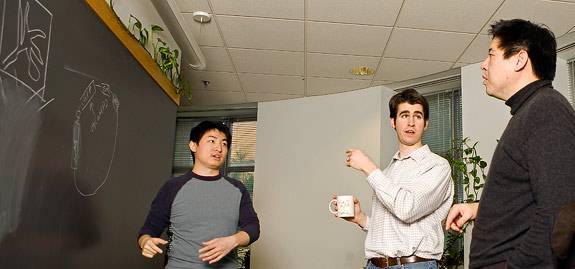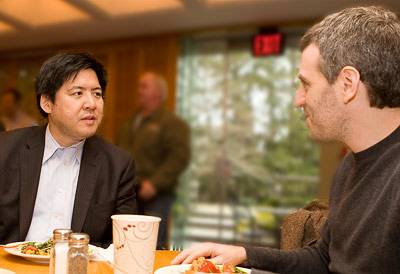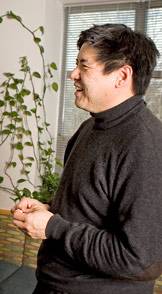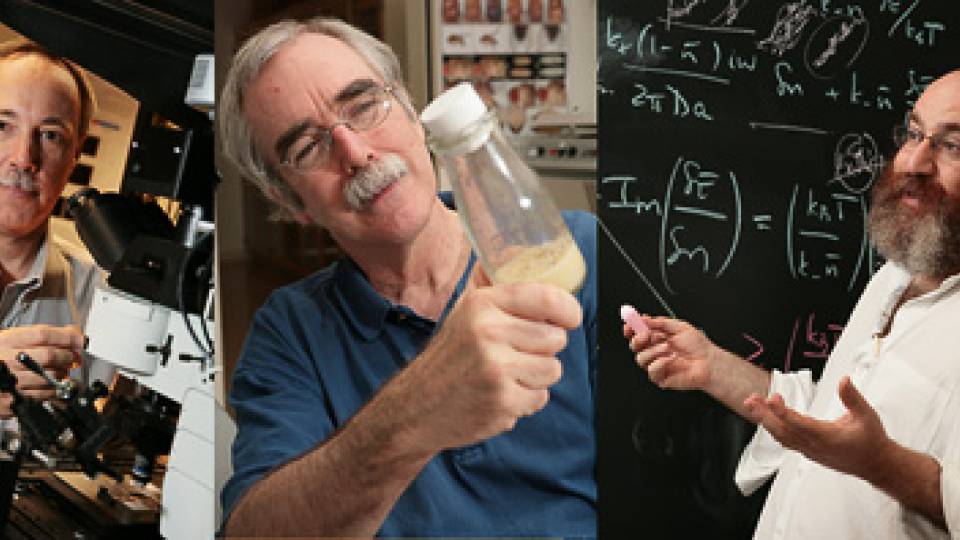It's a busy afternoon in the Tap Room at Prospect House, with the buzz of a dozen lunch conversations rising above the filled tables.
At a center spot, though, all is quiet.
Sam Wang, Princeton neuroscientist, author, Internet geek, politics junkie, op-ed writer and public speaker, is sitting sideways. He is hunched over and looking down, as if he has dropped something. For once, the loquacious associate professor of molecular biology and neuroscience is at a loss for words.
He has just been asked a sequence of questions that are, in summary, "Why?"
Why, a visitor has queried, would Wang, a researcher with a packed laboratory schedule, take it upon himself to co-write a popular book on the brain? Why does he pepper his work week with so many public talks in so many different places? And why did he create something as unruly, work-intensive and as far removed from biology as the Princeton Election Consortium, a Web-based, meta-analysis of presidential election polls offered in real time throughout the campaign season?
He tries to answer. "Neuroscience is an incredibly interesting subject," Wang says with passion. "Understanding what the brain does, from circuit function to neuron repair, is one of the great outstanding challenges of modern science. If I can just show the public what scientists already know, then they might get a feeling about the excitement in the field."
And the detour into the political realm? Some things, he believes, simply cry out for fixing. "I tend to think in terms of probabilities and statistics," he said. "And I just can't stand it when people misrepresent data."
The world is full of mysteries and problems that continue to perplex many people. For Wang, however, whether the quandary involves deducing how the cerebellum processes human thought or how to improve the public's scientific and statistical literacy, it exerts an inexorable pull on his consciousness, a siren's call to action.
"These things need to be done," Wang said. "In fact, they cry out to be done. And, it's fun."
Wang is definitely having fun. Often, that joy stems from doing what others might see as too much at once. Wang needs it to be that way. Because he really is interested in everything.
"He's one of those rare people who can succeed at just about anything," said Daniel O'Connor, who earned his Ph.D. under Wang in 2006 and is now a postdoctoral associate at the Janelia Farm Research Campus of the Howard Hughes Medical Institute. "And since he's not afraid to pursue his interests, he makes wide-ranging contributions. Whether it's the intricacies of synaptic physiology, in vivo cerebellar function, political polling data meta-analysis or obscure bands, Sam has something insightful to say."
Wang has always been a high-energy sort of guy, interested in many things at once.
"Sam's the kind of adviser who will help develop new statistical methods to analyze your data one moment, then go catch a midnight showing of a new movie the next," added O'Connor.

Students praise Wang for his supportive, inspirational style. Wang teaches through and learns from brainstorming sessions on brain architecture conducted at the chalkboard such as this one with, from left, Richard Sun, a student in the M.D./Ph.D program at Princeton, and Eugene Civillico, a postdoctoral research fellow in Wang's lab.
Beautiful circuitry
As a youth in Riverside, Calif., Wang zipped through high school in two years. His parents -- his late mother, Mary, and his father, Chia-lin Wang -- always encouraged him, the oldest of their three children. He jumped into physics at the California Institute of Technology, but became drawn to questions about the brain after taking a course in biophysics in his sophomore year. He wanted to double-major in physics and literature -- he has always enjoyed writing, too -- but ultimately earned a B.S. in the former. At Stanford University, he switched to neuroscience and received his Ph.D., but not before immersing himself in a self-taught crash course in biology, playing catch-up with many of his more organically oriented colleagues.
He spent a year as a postdoctoral fellow at Duke University, but felt called to try something else. A Congressional Science Fellowship granted by the American Association for the Advancement of Science was just the ticket, allowing him a year away from the lab, first as a legislative assistant for U.S. Rep. Lloyd Doggett of Texas and then as a legislative fellow for U.S. Sen. Edward Kennedy of Massachusetts. At the end of his term, he was invited to apply for a job with the Clinton White House. He opted instead to rejoin his colleagues in the scientific life at Duke.
After completing his postdoctoral studies, he spent two years at Bell Laboratories in Murray Hill, N.J., where he learned to use ultrafast pulsed lasers to study brain signaling before coming to Princeton in 2000. He arrived with a sense of mission and a desire to understand and appreciate the elegant organization of the cerebellum, the region that integrates sensory information and coordinates action and movement.
"The circuitry is so beautiful," Wang said. "It looks like you should be able to understand it by doing some simple experiments. But that's not the case."
The cerebellum is also critically involved in autism, a developmental disorder characterized by impaired social interaction, difficulties in communicating and other behaviors. Wang's sister, Karen, has autism. "It's not the main reason or motivator for what I do, but it gives these problems added emotional weight," he said.
Researchers are familiar with the raw anatomy of the cerebellum. Among its constituents are microscopic neurons known as Purkinje cells, shaped liked flattened trees. It all looks quite orderly. When something goes wrong, no one knows why.
Wang is vitally interested in these Purkinje cells, which form the middle layer of the cerebellum and ferry information processed by that part of the brain. They also possess a great deal of control over the refinement of motor activities. Each Purkinje cell receives hundreds of thousands of signals through its dendrite, the elaborate treelike structure seen emerging from the cell body.
Understanding how the cells work together and what can go wrong could help Wang develop insights into diverse neurological problems ranging from movement disorders to autism.
Wang, who has now published more than 50 articles on the brain in leading scientific journals, said the answers could hinge on the fact that the cerebellum processes information by its whole ensemble of parts. Until recently, scientists lacked the capability of studying the entire "circuit" of a thought through the cerebellum. Looking at one cell at a time is not enough. Scientists need to monitor what whole groups of cells are doing, he said.
Wang's lab achieves this through experiments that employ lasers to detect sequences of chemical signals emitted by thousands of Purkinje cells as they receive and then transmit information.
"We want it so that the whole choir is available to you," Wang said. "You wouldn't know if you only worked on one cell." He is currently interested in the fact that, in order to transport information about sensations and movement, these cells use synchrony, a term that describes their ability to fire together to convey interesting events. "It's as if the voices in the choir sing out of unison most of the time, but occasionally come together to generate a moment of dramatic impact," he said.
A crucial part of his lab work is inspiring students to play a role.
"One afternoon, Sam and I were talking about the experiments we thought someone needed to do and, by the end of the conversation, he convinced me to make the measurements myself," said Gayle Wittenberg, who worked with Wang for five years, first as a Ph.D. student, then as a postdoctoral fellow.
He is legendary among students for his support.
"Sam has hosted more parties, celebrations and impromptu barbecues for his lab than any other faculty member I have known," added Wittenberg. "And the education of any non-U.S. citizen includes a thorough introduction to American slang, including the complete etymology of each phrase."
His boundless energy is always part of the equation.
"I remember setting up meetings for 1 p.m. which would finish at 8 p.m. with us getting dinner at Frist; the conversation would range from the nitty-gritty of the statistics we were using to 80-year-old papers on lemurs to election politics and the workings of the Senate," said Damon Clark, who co-wrote a Nature paper with Wang when Clark was an undergraduate.
And conversations are rarely pedestrian.
"What I like best about talking to Sam is the sheer number of analogies he produces -- it's got to be something like one every five minutes -- definitely an order of magnitude more than anyone else I know," said Clark, now a postdoctoral fellow in neuroscience at Stanford University.
In between the analogies, he spends a lot of time making fun of himself. For example, he will tell audiences that he has "an unfortunate dependence on the Web and e-mail" when he knows full well what the research shows -- simultaneously doing mentally demanding tasks slows performance significantly. "This is a case where I am not making good use of research -- I'm a hypocrite!" he jokes.

Wang is driven by social encounters to dig deeper into his research. At places like the Tap Room in Prospect House, he catches up with colleagues, such as Princeton biologist David Stern. "I'm very socially oriented and much more likely to think productively when I am working with others, rather than being alone," Wang said.
A book about brains
Sometime after arriving at Princeton, his schedule packed with teaching, running his lab and publishing papers, Wang nonetheless started to think, too, about producing a book that might popularize brain science. In 2003, a friend informed him that a colleague, Sandra Aamodt, the editor of Nature Neuroscience, had been working on the same idea. The friend put them together, and they agreed to collaborate.
Aamodt and Wang worked on the project on and off for three years, each taking turns writing chapters with the other one editing. "It was an ideal writing partnership," Wang said. In April 2006, anxious to finalize the project, they obtained a writer's residency grant from the Rockefeller Foundation. The funding allowed them to finish the book during a one-month stay the following summer at the foundation's picturesque study center in Bellagio, Italy.
The compressed time schedule and the interactive nature of the set-up motivated Wang. "I'm very socially oriented and much more likely to think productively when I am working with others, rather than being alone," Wang said. Not only did he finish the book, but he proposed on the shores of Lake Como to his girlfriend, Rebecca Moss, an oncologist. They married shortly after, in September 2006. They are now the proud parents of a daughter.
The book, "Welcome to Your Brain: Why You Lose Your Car Keys but Never Forget How to Drive and Other Puzzles of Everyday Life," published by Bloomsbury USA early last year, has been a critical success, with Publishers Weekly describing it as "a terrific, surprisingly fun guide for the general reader." It recently won a prize for excellence in science books from the American Association for the Advancement of Science. And it's a popular success, too, propelling Wang during a sabbatical leave to talk his way through dozens of press interviews, book signings and conversations with cab drivers. He has focused on stressing how relevant brain science is to everyday experience. "Our brains are the generators of who we are and what we do," Wang said. "A central premise of our book is that neuroscience is a pivotal part of everyday life."
Fascinated by the workings of the brain, he has spread the word with the goal that everyone should know what he already knows. And he has met a willing audience, loaded with questions.
Crowds pick up on Wang's enthusiasm, his conviction that anyone who comes to understand some of the contributions of neuroscience will appreciate it as much as he does, according to his co-author. "Sam has a talent for talking to nonspecialists in a way that's meaningful to them, especially by connecting science to everyday life, while also being careful to get the facts right," Aamodt said. "Also, he finds a wide range of people interesting, which helps him connect with them. Audiences respond to that approach with great appreciation, which rewards him for making the effort."
Some questions, posed as enduring mysteries by many people with whom he has spoken, are really anything but. For example, contrary to popular belief, he said, women are not moodier than men. Scientific studies show that men and women are equally moody. However, studies also show that men and women recall the mood swings of women more often than they remember the mood swings of men.
Other queries bedeviling the public, however, remain mysteries to scientists, too. Why do we dream, asked someone during a book-touting visit by Wang and Aamodt to Google headquarters in Mountain View, Calif. "We don't know why," Wang answered.
The book, written in a down-to-earth style and divided up into easily digestible chapters, sidebars and quirky illustrations, answers a host of questions. Why can't we tickle ourselves? What's the best way to keep our brain nimble all through life? And how can we improve our willpower? The authors answer all of these in a text that is designed to dispel common myths about the brain and provide a comprehensive "user's guide."
Stories worth telling
Back from sabbatical, Wang's many activities continue.
A polished public speaker, he recently ran a workshop to help fellow scientists communicate more clearly at the annual Society of Neuroscience meeting in Washington, D.C., with another popular brain science writer, Daniel Levitin. Wang returned to campus the next day to nimbly introduce fellow author Walter Isaacson for a University-wide public lecture series, and was on the train by dawn the next day, headed back to Washington, D.C., to help present his lab's posters. Later that day he returned north to Philadelphia, where he participated in a panel discussion on the brain.
His Princeton Election Consortium forecast -- the meta-analysis devised to predict the results of the November 2008 presidential election -- was just about dead on. He projected that Barack Obama would win 364 electoral college votes to John McCain's 184. With the actual count of Obama versus McCain at 365 to 183, he was only off by 1.
And he continues to co-write frequent and popular op-ed pieces for national publications. One New York Times essay, which linked exercise to improved brain function later in life, was the most e-mailed article of November 2007.
He is moved to act by the philosophy of the humanist biologist E.O. Wilson, whose 1998 book, "Consilience: The Unity of Knowledge," attempted to bridge the culture gap between the sciences and the humanities.
"Scientific illiteracy is bad for our society -- it leads to a lack of understanding and prevents us from becoming enlightened and moving in a good direction," Wang said. "Scientists are doing great things, and there are a thousand stories worth telling."

